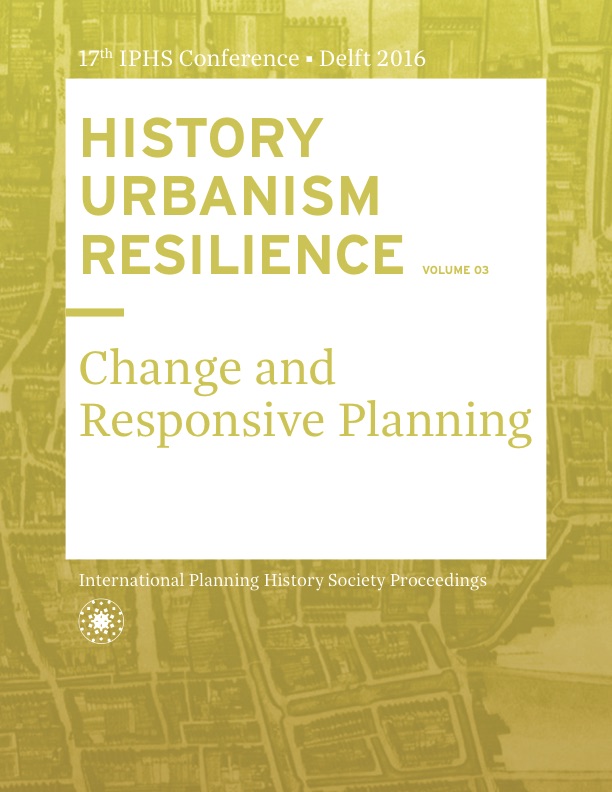Antwerp City Wastescapes. Historic interplays between waste & urban development.
DOI:
https://doi.org/10.7480/iphs.2016.3.1261Abstract
This paper analyses waste management and the production of space over time in the city of Antwerp, Belgium. By reconstructing how shifting waste practices simultaneously reshape our urban environments at multiple scales, this paper also articulates historic interplays between waste management, urban development and planning practices. Benefiting from available waste processes and materials is a practice that disappeared during industrialisation scale jumps and more linear processes of urbanisation and consumption indeed dominate the current practices. But cities like Antwerp are rethinking these resource consumptive processes and orienting their policies towards what is generally labelled as a resource independent ‘circular economy’. In order to be resilient for climate change, Antwerp’s centralized and heavily engineered and stressed waste collection and treatment installations of the last century require revision, if not systemic redefinition. After a century of dumping on peripheral locations, bottom-up initiatives such as repair cafés, zero waste shops, green schools and even supermarkets are changing the cultural appreciation of ‘waste’ in Antwerp by pulling ‘waste practices’ back into the city and activating social community spaces. What can we learn from the historic interplays between waste and urban development in Antwerp at the eve of Antwerp’s next –circular- waste geography?References
Antwerpen, Stad. “Bestuursakkoord 2013-2018.” 2013.
Anversoise, Commission d’études pour l’aménagement de l’agglomération. “Rapport Du Comité Technique Sur L’écoulement Des Eaux Naturelles Et Résiduaires D’anvers Et De Sa Banlieue.” edited by Ministère de l’Agriculture et des Travaux Publics, 128. Anvers, 1912.
Barles, Sabine. L’invention Des Déchets Urbains: France (1790-1970) Editions Champs Vallon, 2005.
Brinckman, Bart. “Stad Erg Kwetsbaar Voor Klimaatverandering. Hitte En Overstroming.” De Standaard, 2015.
De Meulder, Bruno, Jan Schreurs, Annabel Cock, and Bruno Notteboom. “Sleutelen Aan Het Belgische Stadslandschap = Patching up the Belgian Urban Landscape.” OASE: tijdschrift voor architectuur = OASE: architectural journal, no. 52 (1999): 78-113.
de Silguy, Catherine. Histoire Des Hommes Et De Leurs Ordures : Du Moyen Âge À Nos Jours. Paris Le cherche midi, 1996.
Delatter, Christof. “Wereldafvalcongres Komt Naar Antwerpen.” Lokaal, no. 7 (2015).
Di Palma, Vittoria. “Wasteland : A History.” 2014.
Feys, Torsten. Ovam 30 Jaar. De Openbare Vlaamse Afvalstoffenmaatschappij in Historisch Perspectief. Gent: Academia Press, 2011.
Ford, Henry, and Samuel Crowther. Today and Tomorrow Cambridge: Cambridge : Productivity Press, 1988.
Kostof, Spiro. The City Assembled: The Elements of Urban Form through History. London: London : Thames and Hudson, 1992.
Lampo, Jan. “Huisvuil En Hygiëne in Antwerpen Door De Eeuwen Heen. Stank in De Stad.” EOS - Memo (2016).
Lijn, De. “Omleggen Van De Ruien.” http://www.tramstad.be/omleggen-van-de-ruien/.
MacArthur Foundation, Ellen. “Towards the Circular Economy Vol.1.” (2013).
Mumford, Lewis. Technics and Civilization. 2e ed. ed. New York (N.Y.): New York (N.Y.) : Harcourt, Brace and World, 1963.
Poulussen, Peter. Van Burenlast Tot Milieuhinder: Het Stedelijk Leefmilieu 1500 - 1800. Kapellen: Kapellen : Pelckmans, 1987.
Rosso, Caterina; Van Maercke, Carmen. “Dirty Antwerp: Re-Engineering Flows, Editing the 20th Century Belt.” KULeuven, 2015.
Ruien visit. “Onder de stad stromen geheimen”. Accessed 30 March, 2016. http://ruien.be/nl/
Stadsarchief Antwerpen. “AVA.” Accessed April 1, 2016. http://zoeken.felixarchief.be/zHome/Home.aspx
Tarr, Joel A. “The Search for the Ultimate Sink : Urban Pollution in Historical Perspective.” Akron, Ohio: University of Akron press, 1996.
Vandecasteele, Karlien. “Ruimte Voor Het Schijn.” Artesis Hogeschool, 2006.
Willems, Patrick. “Impact Van De Klimaatverandering Op Antwerpen.” Waterproef, 2015.

